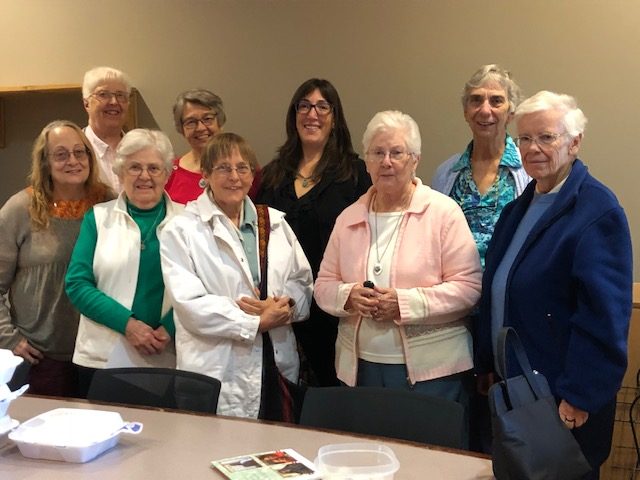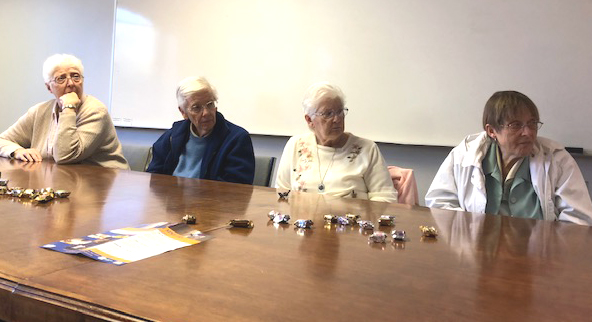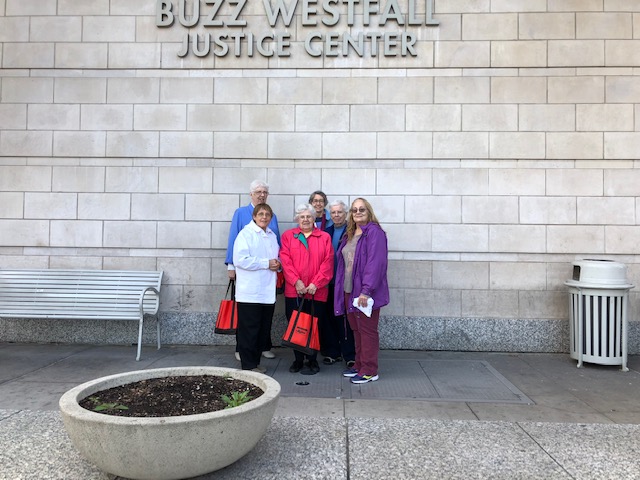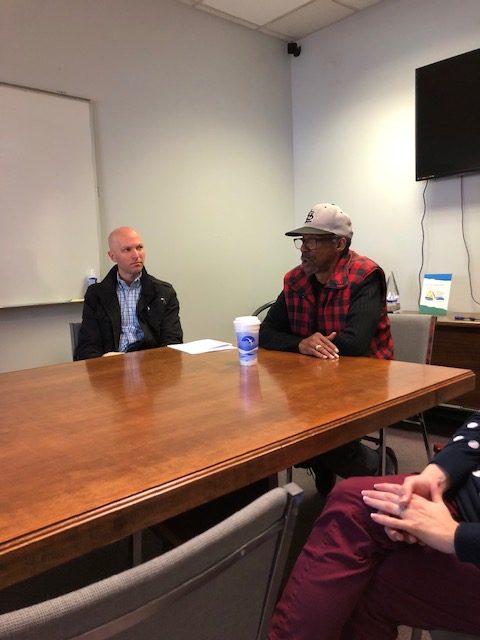
The Map experience at CWIT. Front row: Associate Rosalie Durante, Sisters Sharon Rose, Lucy Nigh, Millie Lodeke, Pat Ferrick. Back row: Sisters Geraldine Neier, Rose Huelsmann, Director Laura Toledo, Sister Joyce Engle.
Reflection on MAP Prison Experience
The first MAP experience with Prison Ministry took place in St. Louis, Missouri, Oct. 14-17, 2018. Sister Rose Rita Huelsmann, SSND, organized and led the process. The composition of the group participating included Sisters Lucy Nigh and Pat Ferrick from Douglas, Arizona, Associate Rosalie Durante from Milwaukee, Anna Muckerman (for one day) employee of CJM, Sisters Sharon Rose Terbrock, Mildred Loddeke, Joyce Engle, Geraldine Neier from St. Louis and connected with CJM. Each person in the group had some experience of prison ministry which enriched the discussions and reflective sharing each day. There were significant differences in the experiences of each person, however, we all could address challenges we met in our daily working in a system that is far beyond our control.
The Maximum-Security Prison in Potosi, Missouri (about 1 & 1/2 hours from St. Louis), St. Louis County Jail in Clayton, Criminal Justice Ministry (CJM) and Center for Women in Transition (CWIT), both in South St. Louis, were the four sights visited.

From left to right: Sisters Geraldine Neier, Pat Ferrick, Mildred Loddeke, Lucy Nigh at the board table listening to case manager and former client Jerome and the current Executive Director Anthony.
Each place had its special message. While inside a facility, we were constantly reminded that the thousands of inmates had little or no freedom. The dehumanizing effect could not be missed as prisoners stared out of their cells at us. The men at CJM and the women at CWIT had years to make up and many stigmas to overcome in their transition back to normal living.
We met seven men in the “Puppies for Parole” program at Potosi who were training rescue dogs for adoption. This made a huge impression on us. These trainers were not only training the dogs but were themselves learning the discipline necessary to succeed in a free society. Another aspect which caused us to reflect was the number of persons who are incarcerated because appropriate facilities for them did not exist anywhere else – mental health, drug addiction, etc. In the evening of this first day we watched “God in Death Row,” a movie filmed in Potosi, with a message about conversion on death row.
St. Louis County Justice Center houses approximately 1100 inmates. It has a capacity of 1232. We did not see the women’s area but were given a tour of the general areas that were empty. The center is located in the affluent part of the County by the county seat with easy access to the courts. Entrance to this jail was through heavy security, the same as the maximum prison. We were clearly instructed to remember that we may be gullible and that prisoners are aware of that.
We had the opportunity to observe an ESL class, taught by two very experienced volunteers. Still we found it a very challenging environment. There were 15 students in the small room. We were made aware of the red button on the wall which would bring assistance if needed. Again, the cautionary directions made it challenging in terms of how we could relate to the students. Perhaps it should not be surprising in an ESL class that students were truly international; they did seem to have a good command of the language. What was their future? Are they waiting to be deported?
On the last day of our experience we visited two agencies that are helping people pick up the pieces as they are released from incarceration to the parole system or to no kind of support system. CJM had been a support to inmates since 1979. It started a scattered housing program for returning citizens in 2003 and recently added apartment buildings to their housing programs. This agency also has a wide variety of programs for inside ministry such as pen pal, HiSet classes, religious services, anger management etc. It offers bus tickets, clothing, back packs with hygiene items and underwear etc. for people just released from incarceration. It serves both men and women. Several SSNDs are employed or volunteer at this ministry. The School Sisters of Notre Dame Central Pacific Province has also supported it with grant funding.
The Center for Women in Transition has been a care circle for women over 20 years. They use apartments to house women who have recently been released from prison. They have wrap around services to support them on the road to success similar to what CJM offers. They are beginning to collaborate with housing possibilities. Volunteer positions are available in both programs.
The overall three-day experience was challenging, perhaps almost not pleasant. The richness of sharing in the evening was positive. It was a learning experience and gave each of us new insights into our daily ministries. “We were inspired to keep doing our little part” said one participant. Another participant said “this experience was so important to me for my sanity and confirming that my work is meaningful and there is purpose to continuing my work and advocacy for people in custody.”
All reflections written by Sisters Rose Rita Huelsmann and Geraldine Neier, SSND.
Sunday evening, Oct. 14,
Beginnings
Our get acquainted night brought the eight of us together. Sisters Lucy Nigh and Pat Ferrick from Douglas, Arizona, associate Rosalie Durante from Milwaukee, Sisters Sharon Rose Terbrock, Mildred Loddeke, Joyce Engle, Geraldine Neier, Rose Rita Huelsmann from the community in St. Louis. We had the tour of Sancta Maria in Ripa campus and spoke of its history and the work of SSND in the St. Louis area. We shared chicken soup and cookies and our excitement for this experience. We prayed for hope for all those we would meet and who were involved in the “system.”

Buzz Westfall Justice Center first row: Sister Lucy Nigh, Sharon Rose, Associate Rosalie Durante. Second row: Sisters Geraldine Neier, Rose Huelsmann, Pat Ferrick.
Monday, Oct. 15,
Potosi Maximum Security Prison
The prayer theme of the day was HOPE. We went to a place where hope may be hard to find. After an hour and half trip, we arrived at Potosi Correctional Center and were received by Sargent Bill Leach who was to be our guard and guide for the day. We were introduced to Warden Richard Jennings and Deputy Warden Travis Cruz who spent time explaining their philosophy and the programs for their facility. Warden Jennings had a connection with Notre Dame as his daughter had graduated from NDHS in St. Louis 2016.
We started our tour; the environment was stark. The inmates could be seen observing us from their cell door peep holes as we toured their living areas. This caused us to reflect on the reality of our freedom compared to theirs. We met and talked to four inmates who helped with chapel services. We also met and talked with seven inmates who worked with stray rescue dogs to train them, heal them and make them ready for adoption by people in the community. This was perhaps the most hopeful sign of the day.
In the evening we watched the movie, “God in Death Row,” filmed at Potosi Prison. It featured four inmates and the “Sons of Thunder” ministry. While three of the four men have been executed, the fact that they could each witness to their acceptance of Jesus Christ as Savior gave us an insight into the effects of ministry in prison: a hopeful insight.
Tuesday, Oct. 16,
St. Louis County Justice Center
The St. Louis County Justice Center is located in the middle of the affluent county seat of Clayton. The center is recently constructed with a capacity of 1232 individuals and has 1100 people right now. Advantages of the center are medical assistance, court nearby, open areas for recreation, and direct officer supervision within the pod of 72 inmates. The inmates are released from their cell seven hours each day. The reality of incarceration is strong. The tour of the building was given by Jean Banes, who has been working there for 17 years and relates well to everyone. After that we met with Sheronica Todd who is responsible for the training of volunteers at the jail. “Distrust inmates” was her cautionary message given. Perhaps our obvious gullibility made this message necessary.
We observed briefly an ESL class taught by experienced volunteers. We were struck by the varied backgrounds of the members of this class of 15. We felt some of the men had a hidden agenda. Were they there to get out of confinement for a couple of hours? Were they there to communicate messages to each other? Were they serious about learning English in order to help themselves? Did they have a future in the USA? What a challenging ministry this seemed to be. The two volunteer teachers Cathy Ross and Carol Mock seemed to be accepting the challenge.

Anthony (Executive Director) and Jerome (case worker) at CJM.
Wednesday, Oct. 17,
CJM and CWIT Re-entry Agencies
Criminal Justice Ministry (CJM), where three School Sisters of Notre Dame work, was our morning stop. Center for Women in Transition (CWIT) was our lunch stop. Both agencies help returning citizens pick up the pieces after formal incarceration. They supply basic needs and programs to help them transit to successful living in a free society. CWIT has apartments for clients as well as a halfway house for women. CJM has scattered housing in the community. Most clients in both programs are still involved with the Department of Correction (DOC) as they are on parole.
At CJM we met with the Executive Director Anthony D’Agostino and some of his staff. We heard the witness of Jerome, who successfully adjusted back to society through the CJM program and is now housing other clients employed by CJM as their case worker. We visited the offices of the FIRST services where staff helps clients get bus tickets, identification papers and so much more to meet basic human needs of people trying to live on the outside after years of incarceration.
We had lunch at CWIT with Executive Director Laura Toledo, after visiting “Baker House,” their apartment house for their women clients. Laura told us the story of CWIT and the ways they hope to grow. They hope to enter into more collaboration with CJM.
Both agencies have many volunteer opportunities.
